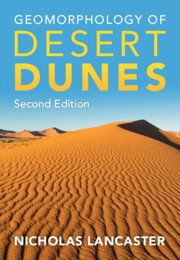Book contents
- Geomorphology of Desert Dunes
- Reviews
- Geomorphology of Desert Dunes
- Copyright page
- Contents
- Preface to the Second Edition
- Acknowledgments
- Part I Introduction and Fundamental Concepts
- Part II Dune Morphology and Sediments
- Part III Dune Processes and Dynamics
- Part IV Boundary Conditions for Dune Formation and Development
- Part V Sand Seas and Dune Fields
- Part VI Dune Systems in Time and Space
- 14 Ancient Dune Systems: The Rock Record
- 15 Quaternary Paleodune Systems
- 16 Planetary Dune Systems
- Part VII Conclusions
- References
- Index
- Plate Section (PDF Only)
15 - Quaternary Paleodune Systems
from Part VI - Dune Systems in Time and Space
Published online by Cambridge University Press: 03 March 2023
- Geomorphology of Desert Dunes
- Reviews
- Geomorphology of Desert Dunes
- Copyright page
- Contents
- Preface to the Second Edition
- Acknowledgments
- Part I Introduction and Fundamental Concepts
- Part II Dune Morphology and Sediments
- Part III Dune Processes and Dynamics
- Part IV Boundary Conditions for Dune Formation and Development
- Part V Sand Seas and Dune Fields
- Part VI Dune Systems in Time and Space
- 14 Ancient Dune Systems: The Rock Record
- 15 Quaternary Paleodune Systems
- 16 Planetary Dune Systems
- Part VII Conclusions
- References
- Index
- Plate Section (PDF Only)
Summary
Quaternary paleodune systems are widespread on the margins of active dune fields and sand seas and in semiarid areas. Despite issues with their visualization and interpretation, luminescence ages for periods of dune accumulation and stability can provide the basis for comparison with other proxy datasets to understand the forcing factors that determine dune activity and stability. These include changes in precipitation and vegetation cover and wind strength and direction.
- Type
- Chapter
- Information
- Geomorphology of Desert Dunes , pp. 263 - 280Publisher: Cambridge University PressPrint publication year: 2023

